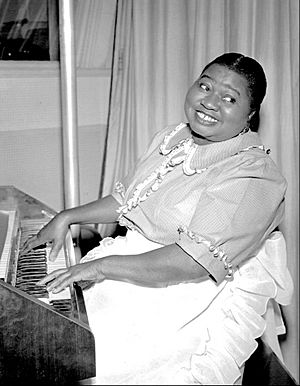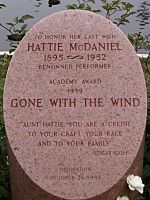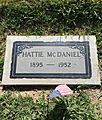Hattie McDaniel facts for kids
Quick facts for kids
Hattie McDaniel
|
|
|---|---|
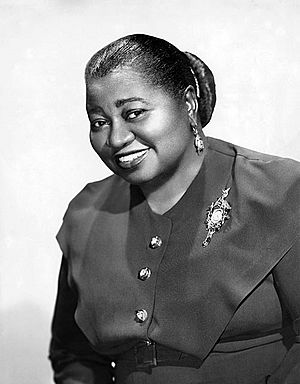
McDaniel in 1939
|
|
| Born | June 10, 1893 Wichita, Kansas, U.S.
|
| Died | October 26, 1952 (aged 59) Los Angeles, California, U.S.
|
| Resting place | Angelus-Rosedale Cemetery |
| Occupation | Actress, singer-songwriter and comedian |
| Years active | 1920–1952 |
| Spouse(s) |
|
| Relatives | Etta McDaniel (sister) Sam McDaniel (brother) |
Hattie McDaniel (born June 10, 1893 – died October 26, 1952) was an American actress, singer, and comedian. She made history when she won an Academy Award for Best Supporting Actress for her role as Mammy in the movie Gone with the Wind (1939). She was the first African American person to ever win an Oscar.
Hattie McDaniel has two stars on the Hollywood Walk of Fame. She was also honored with a U.S. postage stamp in 2006. She was the first Black Oscar winner to receive this honor. In 2010, she joined the Colorado Women's Hall of Fame.
Besides acting, Hattie was also a talented singer. She recorded many blues songs and performed on the radio. She was the first Black woman to sing on radio in the United States. She appeared in over 300 films, though she only received official credit for 83 of them. Some of her other famous movies include Alice Adams, In This Our Life, and Since You Went Away.
Throughout her career, Hattie faced racism and racial segregation. For example, she could not attend the premiere of Gone with the Wind in Atlanta. This was because the theater was only for white people. At the Oscar ceremony in Los Angeles, she had to sit at a separate table away from the other stars. Hattie McDaniel died in 1952 from breast cancer. Her wish to be buried in Hollywood Cemetery was denied because it was also restricted to white people at that time.
Contents
Early Life and Family
Hattie McDaniel was born in 1893 in Wichita, Kansas. She was the youngest of 13 children. Her parents had been enslaved before. Her mother, Susan Holbert, was a gospel music singer. Her father, Henry McDaniel, fought in the Civil War.
In 1900, Hattie's family moved to Fort Collins, Colorado, and then to Denver, Colorado. Hattie went to Denver East High School from 1908 to 1910. In 1908, she won a contest by reciting a poem.
Hattie's brother, Sam McDaniel, was also an actor. He played a butler in a Three Stooges short film. Her sister Etta McDaniel was an actress too.
Hattie's Career Journey
Early Performances and Radio Work
Hattie McDaniel was a singer and a songwriter. She improved her songwriting skills while working with her brother Otis's carnival company. This was a type of traveling show called a minstrel show. In 1914, Hattie and her sister Etta Goff started their own all-female minstrel show.
After her brother Otis passed away in 1916, their group struggled. Hattie didn't get another big opportunity until 1920. From 1920 to 1925, she performed with Professor George Morrison's Melody Hounds. This was a Black touring music group.
In the mid-1920s, Hattie started her radio career. She sang with the Melody Hounds on station KOA in Denver. From 1926 to 1929, she recorded many of her songs. She recorded for Okeh Records and Paramount Records in Chicago.
When the stock market crashed in 1929, it was hard to find work. Hattie could only find a job as a washroom attendant at a club. Eventually, the owner let her perform, and she became a regular singer there.
Moving to Hollywood
In 1931, Hattie moved to Los Angeles to join her brother Sam and sisters Etta and Orlena. When she couldn't find film work, she worked as a maid or cook. Her brother Sam helped her get a spot on a KNX radio show called The Optimistic Do-Nut Hour.
On the radio, she played "Hi-Hat Hattie," a bossy maid. Her radio show became popular. But her pay was so low that she still had to work as a maid.
Hattie's first film role was in The Golden West (1932), where she played a maid. She also appeared in the successful Mae West film I'm No Angel (1933). In this movie, she played one of Mae West's maids. In the early 1930s, she had many uncredited roles, often singing in choruses.
In 1934, Hattie joined the Screen Actors Guild. This helped her get more attention and bigger film roles. She started getting credit for her work on screen. Fox Film Corporation signed her to appear in The Little Colonel (1935). In this film, she acted alongside Shirley Temple and Bill "Bojangles" Robinson.
Judge Priest (1934) was her first major role. She sang a duet with the star, Will Rogers. Hattie and Rogers became good friends. In 1935, she had important roles in Alice Adams and China Seas with Jean Harlow and Clark Gable. She also appeared in Murder by Television with Béla Lugosi.
Hattie was in the 1938 film Vivacious Lady with James Stewart and Ginger Rogers. She had a special role as Queenie in the 1936 film Show Boat. In this movie, she sang a song with Irene Dunne and Paul Robeson. After Show Boat, she had big roles in Saratoga (1937) with Jean Harlow and Clark Gable.
Hattie was friends with many famous Hollywood stars. These included Joan Crawford, Bette Davis, Shirley Temple, Henry Fonda, Olivia de Havilland, and Clark Gable. She starred with Olivia de Havilland and Clark Gable in Gone with the Wind (1939).
Around this time, some people in the Black community criticized Hattie. They felt she accepted roles that showed Black people in a limited way, often as sassy maids. However, these were often the only roles available to Black actors at the time. Hattie became best known for playing strong, opinionated maids.
Her Role in Gone with the Wind
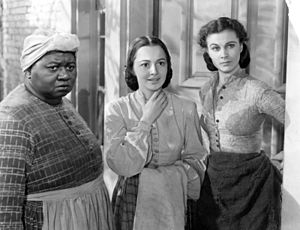
Getting the part of Mammy in Gone with the Wind was very competitive. Even First Lady Eleanor Roosevelt suggested her own maid for the role. Hattie didn't think she would get it because she was known for comedy. But she went to her audition dressed in a real maid's uniform and won the part.
Before the movie was made, the National Association for the Advancement of Colored People (NAACP) worked to remove racist words and change scenes. Some offensive language was changed, but some remained. The movie's message about slavery stayed mostly the same.
The movie's premiere was in Atlanta, Georgia, on December 15, 1939. The studio head, David O. Selznick, wanted Hattie to attend. But MGM told him she couldn't because of Georgia's segregation laws. Clark Gable threatened not to go unless Hattie could. But Hattie convinced him to attend anyway.
Hattie could not go to the Atlanta premiere because of Jim Crow laws. But she did attend the Hollywood premiere on December 28, 1939. Her picture was also shown in the movie program.
Winning the Oscar For her performance as Mammy, Hattie McDaniel won the 1939 Academy Award for Best Supporting Actress. She was the first Black actor to be nominated for and win an Oscar. Hattie said she understood Mammy because her own grandmother worked on a plantation.
Some white audiences in the South complained that Hattie's character was too "familiar" with her white owners. But her character was similar to how Mammy was shown in the book.
Many Black people were happy for Hattie's win. But they also felt it was bittersweet. They believed Gone with the Wind celebrated slavery. They felt that Hattie's award suggested that only Black actors who didn't challenge Hollywood's stereotypes could succeed.
The Oscar ceremony was at the Ambassador Hotel in Los Angeles. A famous writer named Louella Parsons wrote about that night:
Hattie McDaniel earned that gold Oscar by her fine performance of 'Mammy' in Gone with the Wind. If you had seen her face when she walked up to the platform and took the gold trophy, you would have had the choke in your voice that all of us had when Hattie, hair trimmed with gardenias, face alight, and dress up to the queen's taste, accepted the honor in one of the finest speeches ever given on the Academy floor.
Academy of Motion Picture Arts and Sciences, fellow members of the motion picture industry and honored guests: This is one of the happiest moments of my life, and I want to thank each one of you who had a part in selecting me for one of their awards, for your kindness. It has made me feel very, very humble; and I shall always hold it as a beacon for anything that I may be able to do in the future. I sincerely hope I shall always be a credit to my race and to the motion picture industry. My heart is too full to tell you just how I feel, and may I say thank you and God bless you.
Hattie received a plaque-style Oscar. She and her guest had to sit at a separate table at the back of the room. The hotel usually did not allow Black people, but they made an exception for Hattie. After the ceremony, her white co-stars went to a club that did not allow Black people, and Hattie was not allowed to enter.
Another Black woman did not win an Oscar for 50 years. This was Whoopi Goldberg, who won Best Supporting Actress for Ghost.
Gone with the Wind won eight Academy Awards. The American Film Institute (AFI) later named it one of the top American films of all time.
Later Work and Beulah
In the film In This Our Life (1942), Hattie again played a domestic worker. But this time, her character faced racial issues when her son was wrongly accused of a crime. Hattie also appeared in Thank Your Lucky Stars (1943) with Humphrey Bogart and Bette Davis.
During World War II, Hattie continued to play maids in movies like The Male Animal (1942) and Since You Went Away (1944). She also played "Aunt Tempy" in Disney's Song of the South (1946).
Her last film roles were in Mickey (1948) and Family Honeymoon (1949). In 1949, she also appeared on the live CBS television show The Ed Wynn Show.
In her final years, Hattie was very active on radio and television. She became the first Black actor to star in her own radio show, a comedy series called Beulah. She also starred in the TV version of the show. Beulah was very popular and earned Hattie a good salary. However, the show was also controversial. Some people felt it showed negative stereotypes of Black men.
In 1951, Hattie learned she had breast cancer. By the spring of 1952, she was too sick to work and was replaced by Louise Beavers.
Hattie's Personal Life
Marriages and Family
Hattie McDaniel was married several times. Her first husband, Howard Hickman, died in 1915. Her second husband, George Langford, died in 1925.
She married James Lloyd Crawford in 1941. Hattie was very happy when she thought she was pregnant, but it turned out to be a false pregnancy. She never had any children. She divorced Crawford in 1945, saying he was jealous of her career.
She married Larry Williams in 1949. But they divorced in 1950 after only five months. Hattie said he caused problems with her work. She was very upset by the divorce.
Helping Her Community
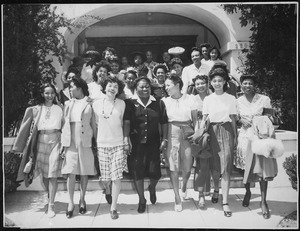
During World War II, Hattie helped a lot. She was the head of the Negro Division of the Hollywood Victory Committee. This group provided entertainment for soldiers at military bases. The U.S. military was segregated then, so Black entertainers had their own committee.
Hattie got help from other Black entertainers. She visited military hospitals, hosted parties, and performed at United Service Organizations (USO) shows. She also helped raise money for the war effort. Bette Davis was the only white actress who performed with Hattie's group for Black soldiers.
Hattie was also a member of the American Women's Voluntary Services. She was known for being very generous. She often lent money to friends and even strangers.
Later Years and Legacy
In August 1950, Hattie McDaniel was hospitalized for a heart problem. She was released in October to recover at home. She died from breast cancer on October 26, 1952. She passed away at a hospital in Woodland Hills, California. Her brother, Sam McDaniel, survived her. Thousands of people came to celebrate her life and achievements.
Hattie wanted to be buried in Hollywood Cemetery. However, that cemetery had a whites-only rule at the time. So, she was buried in Rosedale Cemetery, which was her second choice. In 1999, Hollywood Cemetery offered to move her burial there. Her family declined, but the cemetery put up a special memorial stone for her. This memorial is now a popular spot for tourists.
In her will, Hattie left her Oscar to Howard University. She had been honored by the students there after winning her Oscar. At the time, very few white institutions preserved Black history. So, Black colleges were often where such important items were placed.
Even though Hattie earned a good income, her estate was worth less than $10,000 when she died. The government claimed she owed taxes. So, a court ordered that all her property, including her Oscar, be sold to pay her debts. Years later, the Oscar appeared at Howard University, where Hattie wanted it to be. It was displayed in the drama department. However, it went missing in the 1960s or 1970s and has never been found.
Filmography
Hattie McDaniel appeared in many films throughout her career. Here are some of them:
| Year | Title | Role | Notes |
|---|---|---|---|
| 1932 | The Golden West | Mammy Lou | uncredited |
| 1933 | I'm No Angel | Tira's Maid-Manicurist | uncredited |
| 1934 | Judge Priest | Aunt Dilsey | |
| 1935 | The Little Colonel | Mom Beck | |
| 1935 | China Seas | Isabel McCarthy, Dolly's Maid | |
| 1935 | Alice Adams | Malena Burns | |
| 1936 | Show Boat | Queenie | |
| 1937 | Saratoga | Rosetta | |
| 1939 | Gone with the Wind | Mammy - House Servant | Won Academy Award |
| 1941 | The Great Lie | Violet | |
| 1942 | In This Our Life | Minerva Clay | |
| 1944 | Since You Went Away | Fidelia | |
| 1946 | Song of the South | Aunt Tempy | |
| 1949 | Family Honeymoon | Phyllis |
Radio Appearances
Hattie McDaniel was also a popular radio performer.
- Station KOA, Denver, Melody Hounds (1926)
- Station KNX, Los Angeles, The Optimistic Do-Nut Hour (1931)
- CBS Network, The Beulah Show (1947)
- She was a regular on the radio show Amos 'n' Andy. She played Andy's demanding landlady and later a character named "Sadie Simpson."
Discography
Hattie McDaniel recorded songs, mostly blues, in the 1920s.
| Label | Title | Recorded | Format | Catalogue no. |
|---|---|---|---|---|
| Merrit Records | "Brown-Skinned Baby Doll" / "Quittin' My Man" | 06/26 | Unissued | Merrit 2202 |
| Okeh Records | "I Wish I Had Somebody" /" Boo Hoo Blues" | 11/10/26 | 78 rpm | Okeh 9899/9900 |
| Paramount Records | "Dentist Chair Blues Part 1" / "Dentist Chair Blues Part 2" (with Papa Charlie Jackson) | 03/??/29 | 78 rpm | Paramount 12751 A/12751 B |
Images for kids
-
Publicity photo for Gone with the Wind featuring Hattie McDaniel, Olivia de Havilland, and Vivien Leigh
-
McDaniel leading entertainers from her Los Angeles home to Minter Field for a performance for World War II soldiers in 1942
See also
 In Spanish: Hattie McDaniel para niños
In Spanish: Hattie McDaniel para niños



